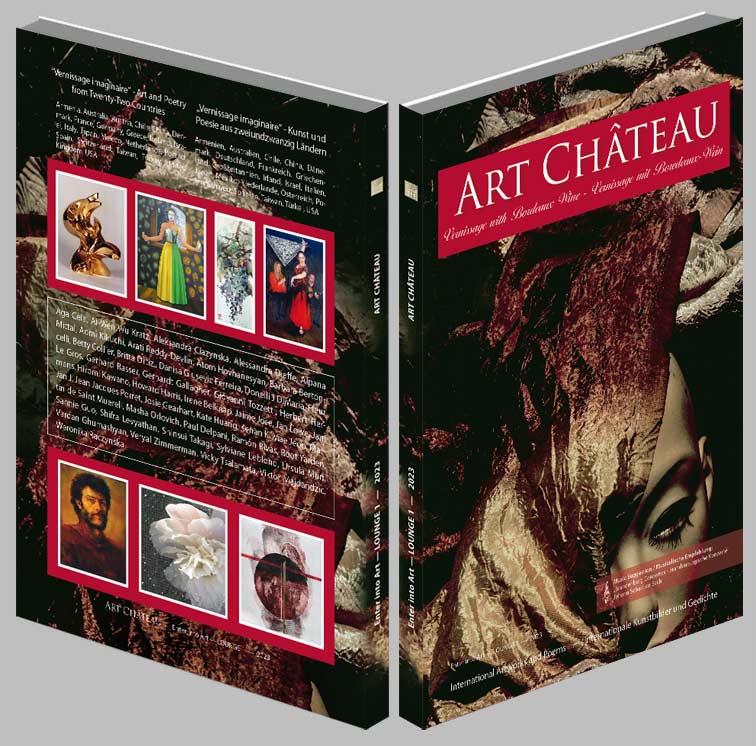Excerpts from the book “Art Château – vol. 1 – Vernissage with Bordeau Wine”
St. Emilion – surrounded by a medieval city wall, even the name of this quaint little town in the Bordeaux wine region breathes spiritual inspiration. Immediately upon entering the town, the stunning ruins of a former Benedictine monastery will tempt visitors to take pictures. The old Franciscan monastery with its gothic cloister with its contemplative combination of ruins and elysian vineyards is another eyecatcher. Like all winemakers around here, the inhabitants bless every path most generously with cases of fine wine. The magic aura of the place will make visitors float through the town’s medieval alleyways. Not a single modern building will disturb their historic sojourn.
A Journey for the Senses in the Region of Bordeaux
From the old, weather-beaten city gate, take a stroll past enchanted gardens and through archways down to the bustling market square where Emilion, a monk from Brittany once dug his hermitage into the karst. In front of a brazen gothic portal and a gorgeous gothic window the photographer’s heart stops to jubilate again. The chapel above this place is dedicated to the Holy Trinity. A side corridor leads to the large caves of a unique Monolithic Church that exudes an almost stone-age like atmosphere. The wineries of St. Emilion had to be built into the lime stone, too – apparently the roots of the vines grow through the ceilings all along the rocky slope.

The text and the poems in this post are excerpts from the book “Art Château, Vol. 1 – Vernissage with Bordeau Wine“.
Countless steps lead back up towards a breathtaking panorama view. Like an amphitheater, the town lies nestled in the rocky canyons. Across the old tiled roofs, the gaze drifts down into the dreamy sun-filled valley with its arcadian vineyards. The Petit Train and a convertible bus take globetrotters to the elegant winemakers’ castles and splendid villas of the area. The spiritual symbol of St. Emilion is a rectangular defense tower that used to be part of the castle in which 800 years ago, the “Jurade” brotherhood was founded in the name of the region’s precious wine. Up in the townhall, year after year, the “Jurats” ring in the wine harvest with a parade wearing scarlet red robes.
The first people to cultivate wine in the region were the Romans. The Bordeaux vines still grow with the same distance between them as they did back then. In the 4th century, the Roman poet Ausonius had a villa near St. Emilion located amidst the vineyards, and to this day, winegrowers in the region keep finding Roman shards or arrow tips from the Bronze age, even a stone axe and a reindeer bone from the prehistoric times of the Dordogne have been excavated here. The “The Venus of Laussel”, a world-famous relief, can be admired in the Musée d’Aquitaine in Bordeaux. In her right hand, the naked female figure holds a bison horn, her oversized sex organs mark her as the idol of a fertility cult.
Art, Picturesque Architecture, and Bordeaux Wine
Like St. Emilion, the port of Bordeaux is a UNESCO world heritage site. The winemaking capital is one of the most beautiful cities in France. The entire city center is under preservation order. With its lakes and endless sand beaches near Arcachon, the landscape around Bordeaux is a summer paradise. Staying clear of extreme temperatures, the vines here get to grow slowly and carefully. Different from other winemaking areas, Bordeaux winemakers use more than one type of grape to create their wine. It is the proportions that lead to its outstanding quality. Visitors can learn more about the subject at the impressive glass building of the „Cité du Vin“. Its modern architecture symbolizes wine being swirled around in the glass: just like the classy beverage, the building changes colors depending on the way the light comes in!
For those more interested in art than in wine, there are two must-see locations in the vicinity of the city. The little town of Verdelais sports the „Auberge Décriteau“, regularly visited by Henri de Toulouse-Lautrec. The painter used to spend the summer days of his short, wine-blessed life with his mother at Château Malrome, located 3 kilometers from there. Apart from his death chamber, the Auberge features reproductions of many of his well-known paintings. The artist’s grave can be visited at the cemetery in Verdelais.
Another must-see is the world-famous cave of Lascaux sometimes called the Sistine Chapel of prehistoric art. The animals on its walls are no longer depicted standing still but shown in motion. The physical features of the cave walls were skillfully incorporated into the paintings. Stringing animal hair through long bones, which were also used to make flutes, the artists created brushes and applied colors made of red ochre, red chalk, black earth, fire residue, and iron oxide to the cave walls. As early as the Neolithic period, art became perfectly polychrome, taking a path comparable to the more recent transition from naturalism to abstraction.
Some haiku poems from the book:
The rosy splendor
Of autumnal vineyard slopes.
A breeze of red wine.
Under fragrant
Trellises an arcadian
View of the river.
In the embrace of
An intricate Maze – Venus
And Bacchus, the child.
Suddenly a scent
Rises up the castle rock.
Jasmine? Oh, blue sky!
Somewhere in the maze
Like alleyways, a stairway
To the wine cellar.
Sources: Please see the authors, poet and bibliography in the above link to the online book (imprint at the end of the book)!
